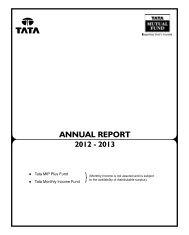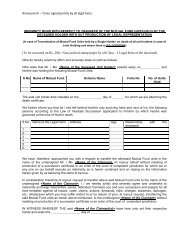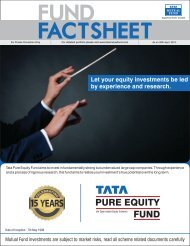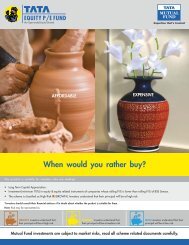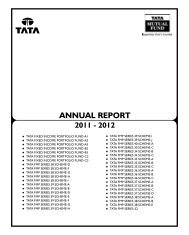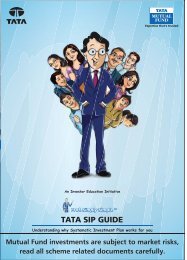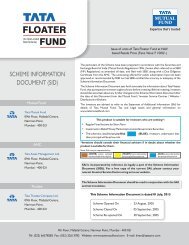Tata Fixed Tenure Fund Series - 2 Scheme B - Securities and ...
Tata Fixed Tenure Fund Series - 2 Scheme B - Securities and ...
Tata Fixed Tenure Fund Series - 2 Scheme B - Securities and ...
Create successful ePaper yourself
Turn your PDF publications into a flip-book with our unique Google optimized e-Paper software.
TATA FIXED TENURE FUND SERIES 2<br />
6. Minimum retention percentage by originator of debts to be securitized<br />
Refer the Table1 in para no.4 above, which illustrates the average seasoning of the debt by the originator prior to securitization. Further, also refer<br />
the same Table, which illustrates additional collaterals taken against each type of asset class, which is preferred over the minimum retention<br />
percentage by the originator of the loan.<br />
7. The mechanism to tackle conflict of interest when the mutual fund invests in securitized debt of an originator <strong>and</strong> the originator in turn<br />
makes investments in that particular scheme of the fund<br />
An investment by the scheme in any security is done after detailed analysis by the <strong>Fixed</strong> Income team <strong>and</strong> in accordance with the investment<br />
objectives <strong>and</strong> the asset allocation pattern of a scheme. All investments are made on an arms length basis without consideration of any investments<br />
(existing/potential) in the schemes made by any party related/involved in the transaction. The robust credit process ensures that there is no conflict<br />
of interests when a scheme invests in securitized debt of an originator <strong>and</strong> the originator in turn makes investments in that particular scheme.<br />
Normally the issuer who is securitizing instrument is in need of money <strong>and</strong> is unlikely to have long term surplus to invest in mutual fund scheme.<br />
Furthermore, there is clear cut segregation of duties <strong>and</strong> responsibilities with respect to Investment function <strong>and</strong> Sales function. Investment<br />
decisions are being taken independently based on the above mentioned parameters <strong>and</strong> investment by the originator in the scheme is based on<br />
their own evaluation of the scheme vis a vis their investment objectives.<br />
8. The resources <strong>and</strong> mechanism of individual risk assessment with the AMC for monitoring investment in securitized debt<br />
The risk assessment process for securitized debt, as detailed in the preceding paragraphs, is same as any other credit. The investments in<br />
securitized debt are done after appropriate research by credit analyst. The ratings are monitored for any movement.<br />
The resources for <strong>and</strong> mechanisms of individual risk assessment with the AMC for monitoring investment in securitized debt are as follows:<br />
• <strong>Fixed</strong> Income Team - Risk assessment <strong>and</strong> monitoring of investment in Securitized Debt is done by a team comprising of Credit<br />
Analyst, Head of <strong>Fixed</strong> Income <strong>and</strong> Head of Research<br />
• Ratings are monitored for any movement - Based on the cash-flow report <strong>and</strong> analyst view, periodic review of utilization of credit<br />
enhancement shall be conducted <strong>and</strong> ratings shall be monitored accordingly.<br />
• Wherever the schemes portfolio is disclosed, the AMC may give a comprehensive disclosure of Securitised debt instruments held in<br />
line with SEBI requirement.<br />
Note: The information contained herein is based on current market conditions <strong>and</strong> may change from time to time based on changes in such<br />
conditions, regulatory changes <strong>and</strong> other relevant factors. Accordingly, our investment strategy, risk mitigation measures <strong>and</strong> other information<br />
contained herein may change in response to the same.<br />
<strong>Securities</strong> Lending: The <strong>Scheme</strong> may deploy funds of the scheme in securities lending. Not more than 25% of the assets of scheme shall be<br />
deployed in securities lending. The <strong>Scheme</strong> would limit its exposure, with regards to securities lending, for a single intermediary, to the extent of 5%<br />
of the total net assets of the scheme at the time of lending.<br />
As per SEBI (Mutual <strong>Fund</strong>) Regulations 1996, the <strong>Scheme</strong> shall not make any investments in any un-listed securities of associate / group<br />
companies of the Sponsors. The <strong>Fund</strong> will also not make investment in privately placed securities issued by associate / group companies of the<br />
Sponsor. The <strong>Scheme</strong> may invest not more than 25% of the net assets in listed securities of Group companies. The <strong>Scheme</strong> may invest<br />
subscription money received form the investing public before close of the New <strong>Fund</strong> Offer period <strong>and</strong> /or pending allotment of Units, in money<br />
market instrument or in fixed deposits with schedule commercial banks as per SEBI regulations. In addition, TAML on being satisfied or receipt of<br />
the minimum subscription amount can commence investment out of the funds received, in accordance with the investment objective of the scheme,.<br />
Income earned (net of expenses) during the period prior to the date of allotment on units shall be merged with the income of the scheme on<br />
completion of the allotment of the Units. In the event of non receipt of the minimum subscription amount, the Trustee Company shall endure that the<br />
entire amount collected as subscription money is refunded to the Unitholders notwithst<strong>and</strong>ing any loss arising out of such investment during the<br />
interim period.<br />
E. THE INVESTMENT STRATEGIES<br />
The scheme is a close ended Income <strong>Fund</strong> <strong>and</strong> its objective is to generate income <strong>and</strong> / or capital appreciation by investing predominantly in<br />
portfolio of Debt <strong>and</strong> Money Market instruments normally maturing in line with the time profile of the scheme. For the purpose of achieving the<br />
investment objective, each <strong>Scheme</strong> under the fund will invest in a portfolio of securities normally having maturity equal to or less than the maturity of<br />
respective schemes. To attain a capital appreciation the scheme will invest small portion of net asset in equity <strong>and</strong> equity related instruments<br />
companies.<br />
The <strong>Scheme</strong>s would invest in debt securities of companies based on various criteria like sound professional management, Sound track record,<br />
industry scenario, growth prospects, liquidity of the securities, etc. The <strong>Scheme</strong> will emphasise on well managed, good quality companies with<br />
above average growth prospects whose securities can be purchased at a good yield <strong>and</strong> whose debt securities are rated above the Investment<br />
grade by a recognised authority like The Credit Rating <strong>and</strong> Information Services of India Limited (CRISIL), ICRA Limited, Credit Analysis <strong>and</strong><br />
Research Limited (CARE) etc. In case of investments in debt instruments that are not rated, specific approval of the Board will be taken except in<br />
case of Government <strong>Securities</strong> being sovereign bonds. However, in case of investment in unrated securities prior board approval is not necessary if<br />
investment in within the parameters as stipulated by the board.<br />
Under normal circumstances, majority of fund will be invested in Debt, Money Market instruments & Securitised debt. A small portion, upto 20% of<br />
the fund will be invested in equity <strong>and</strong> equity related instruments. Each scheme will have a separate portfolio.<br />
Risk associated with investing in equities<br />
Equity <strong>and</strong> Equity related instruments on account of its volatile nature are subject to price fluctuations on daily basis. The volatility in the value of the<br />
equity <strong>and</strong> equity related instruments is due to various micro <strong>and</strong> macro economic factors affecting the securities markets. This may have adverse<br />
impact on individual securities /sector <strong>and</strong> consequently on the NAV of <strong>Scheme</strong>.<br />
11




